Gothic: 12th to 13th century (ca. 1200)
1/9
There's no tags or description
Looks like no tags are added yet.
Name | Mastery | Learn | Test | Matching | Spaced |
|---|
No study sessions yet.
10 Terms
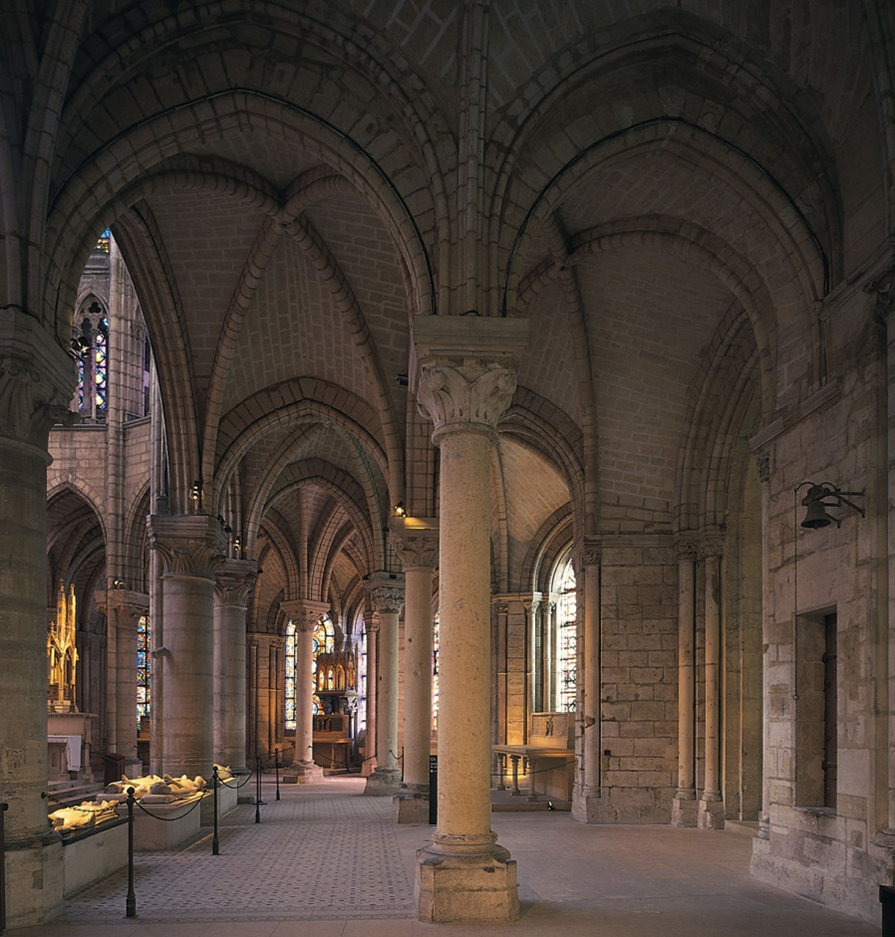
Abbey Church of Saint Denis, France, ca. 1140-1144; 13a, 13-1c, 13-2, 13-3
-Symbolism in the structure
-Su je was the head of the monastery, which they are referred to as avid su je
-He wanted to create a new church, tear down old one, wanted it to reflect his ideas and interpretations
-Wanted greater height/taller and wanted it lighter with daylight
-Main two structures funnel down for a certain usage
-Cathedral is fully mature
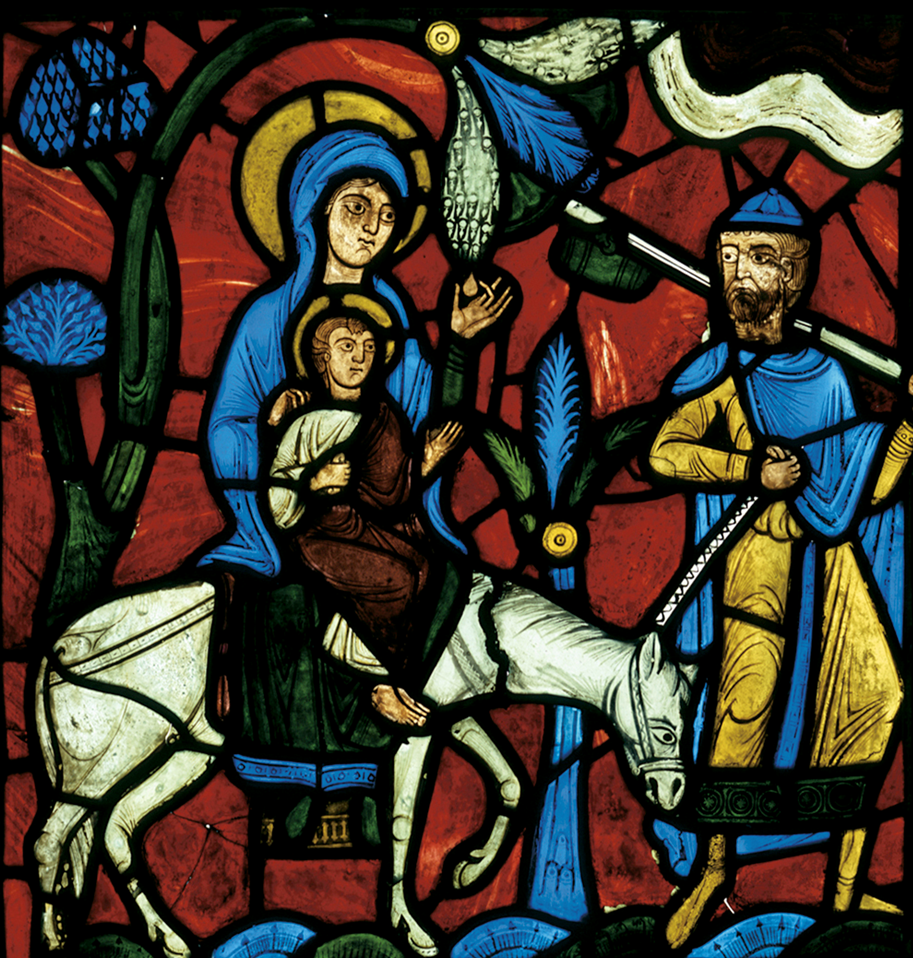
The Flight into Egypt, Incarnation Window, Abbey Church of Saint Denis, France, ca. 1140-1144;
-Stained glass
-With this, it means he can do more with the wall, less wall and more windows
-Windows instead now let in beautiful colors bc of the stained glass with pictorial images filled with color
-Figures, narratives, anything to do with the christian stories, old/new testament
-A little bit of a complicated process of staining glass, cutting it into pieces and put them together within strips of lead
-All features are painted on the glass to represent folds in clothes, faces, etc
-The person trained to do this is trained in the guilds
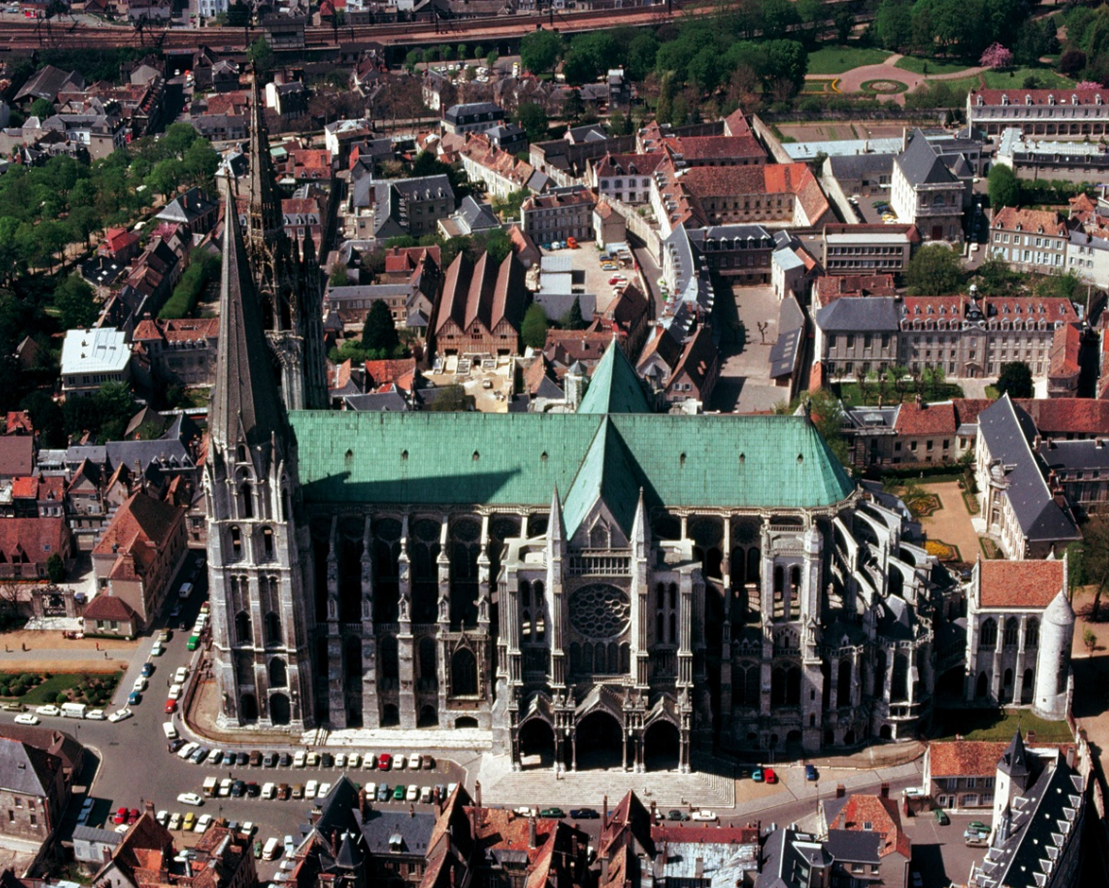
Chartres Cathedral, France, ca. 1134-1260; 13-4, 13-12, 13-13, 13-14
-Located not too far off Paris
-Dedicated to the virgin Mary
-Distinguished by location, france
-Rise in what can be called the cult of mary, or just in general greater want in mary's name, spiritual something bc shes a saint, queen of heaven, etc
-Emphasis on mary being virginal, to signify spirituality and purity, separation of her from the earthly and vessel
-Cathedral created for the worship of christ
-Huge, towers over all other buildings, looking at it with awe
-Pointy towers were added later gothic periods
-Began with the left side in 1134 and built most of the rest of it, then in 1194, there was a fire, and there was a legend that all people came together to help to pay for the rebuilt, guilds financed the rest of the finance
-Guilds show up in the stained glass bc of them helping pay
-External supports , flying buttresses, make it hard to see the windows and walls
-Greater unity in the cathedral, length of it got pushed it, trancept got pushed in, making it more unified
-There's nice details on the flying buttresses, done to decorate, seeing gothic more and more exterior architectural
-There's also a pitch roof covered with tile, protects the stone from rain
-Clear story windows with a stone roof, finally created a solid stone structure with clear story windows without it being able to crash down
-Interior is wider, taller, light is flush with the nave
-Unlike romanesque, the gothic is not as segmented or square, more rounded and the cross is not as obvious
-Symbolic meaning of the stained glass will be explained
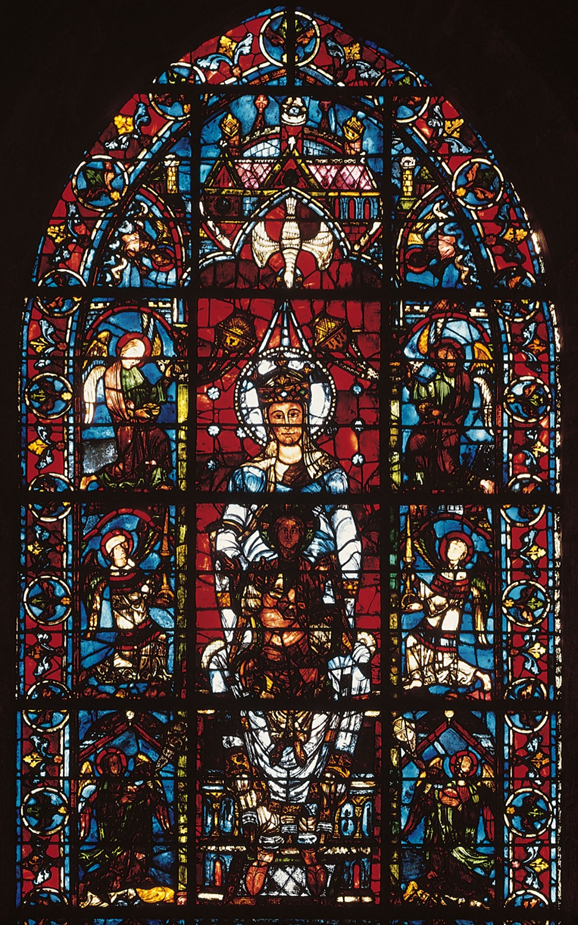
Virgin and Child and Angels Window, Chartres Cathedral, ca. 1170; 13-17
-Similar to the other Virgin and Mary we had before, on the throne of wisdom
-White bird up top is the holy spirit, with the light coming down on her and entering her
-Emphasis on color
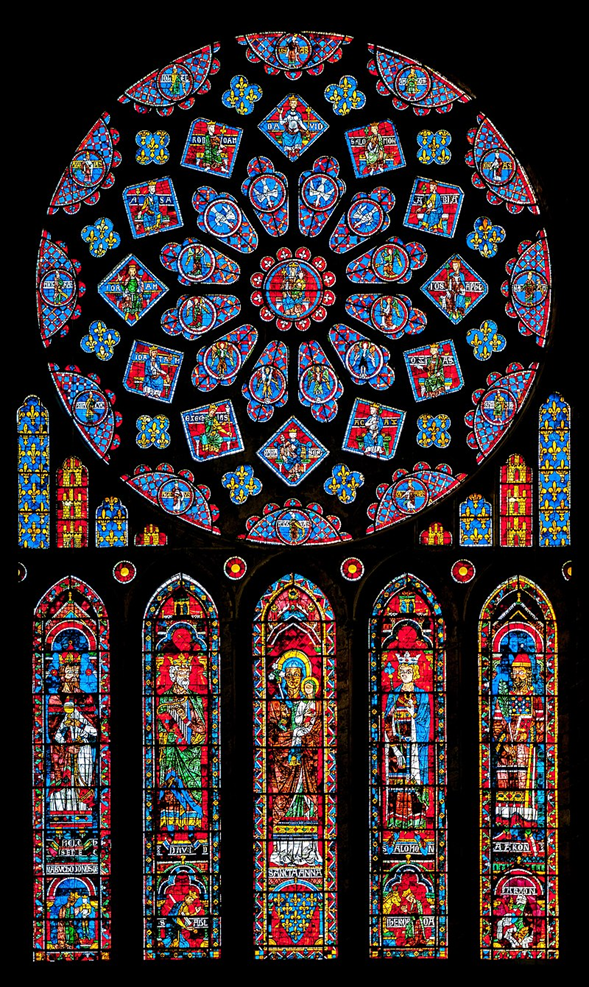
Rose Window and Lancets, Chartres Cathedral, ca. 1220
What is a ROSE WINDOW in Gothic Architecture? | Notre-Dame de Chartres Cathedral in France - YouTube
Transcripts:
(00:00) have you ever heard of notredam cathedral in Paris or notredam cathedral in chart these are two of the most famous medieval buildings in the world one of the most striking features of these beautiful spaces is the amount of colorful stained glass windows including multiple large Rose windows on their front and sides what is a rose window a rose window is a large circular window that you might find in a Catholic Church made during the Gothic era which began in the 12th century and continued in some parts of Europe into the 16th
(00:36) century they're often located on the facade or front of the church and at the ends of the arms of the church which is called the transcept the rose window is composed of stained glass another distinguishing characteristic of Gothic architecture Rose Windows have a distinct appearance almost like a spider's web there's usually a circular shape at the center and forms radiate from it like rays of light or spokes on a wheel the shape resembles the circular appearance of a rose and its petals to create Rose Windows portions of the wall
(01:11) were removed and filled with colorful glass tracery or the ornamental pattern comprised of those thin elements of stone that look like webbing radiating outwards helps to distribute the weight and hold in the glass the shapes that make up the rose window are the same on either side this balanced appearance adds Harmony to the window a rose window symmetry also had a practical function Distributing the Stone's weight evenly the stained glass in Rose Windows could display biblical narratives or figures which would have been appropriate to the
(01:46) setting of a Christian Church the visual Harmony of the window with its perfect geometry and circular shape also communicated the idea of wholeness and so became an important religious metaphor for the whole Ness and Perfection of God the light that poured through the beautifully colored glass in Windows like these also symbolized the Heavenly Jerusalem or Christian Paradise the colorful glass didn't brighten the holy space with light but added a sense of mystery and awe with a kaleidoscope of color while Rose Windows originated
(02:20) before the gothic period they're most commonly associated with the Towering cathedrals of this era such as notredam in Paris or Cathedrals at chart or Ruan

Stonemasons and Sculptors, detail of window, Chartres Cathedral, ca, 1200-1220; 13-16
-Detail, small part of a larger window, picture of men who are in contemporary clothing, building the cathedral, and get credited
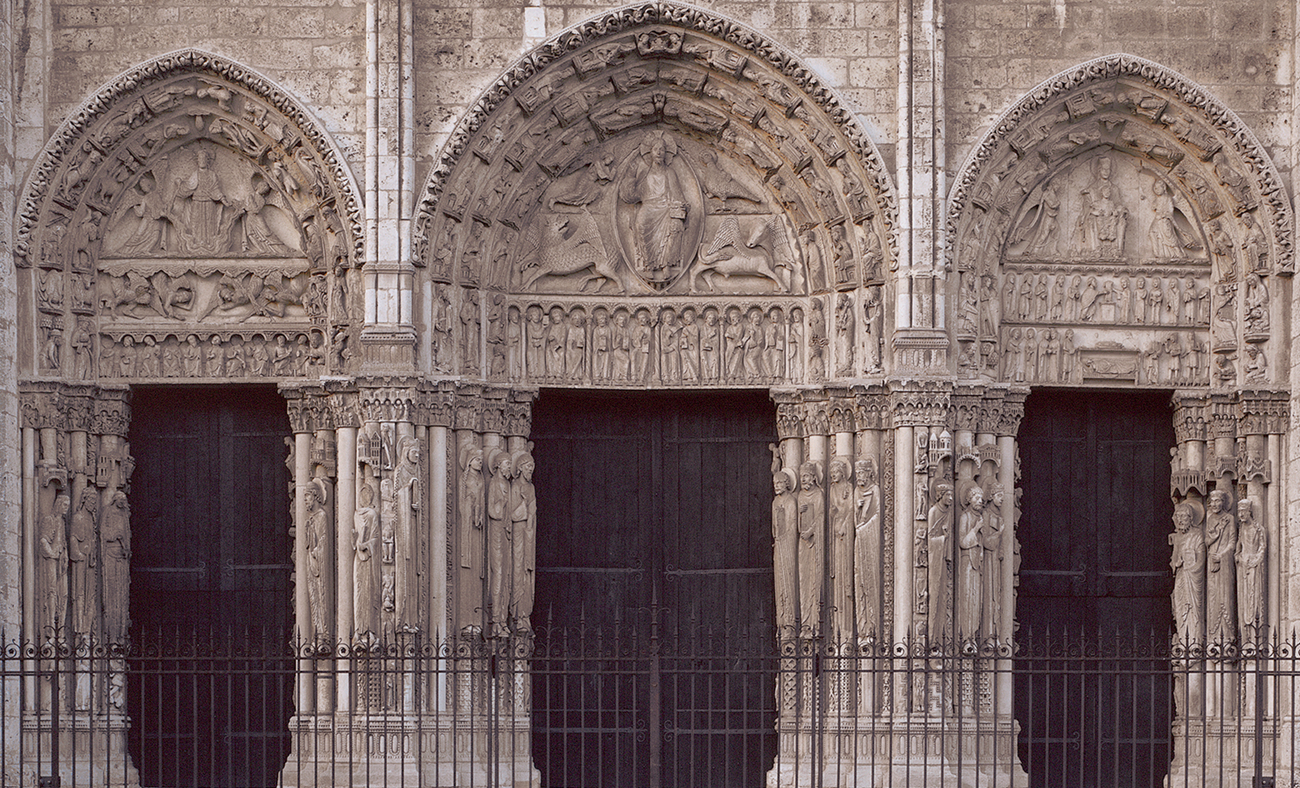
Royal Portal, West Facade, Chartres Cathedral, ca. 1145-1155; 13-5
-Three grand doors with three tympanums
-Beginning on the right tympanum, there are scenes from the infancy, the birth, and childhood of Jesus of Nazareth
-On the leftmost one, has the acension of Jesus the Nazareth to heaven to become Christ
-Go down the infancy, then up for the acension, then drop for the middle which is the Christ in Majesty
-We see Christ here now as a benevolent Judge, NOT Christ as the omnipotent judge (as in St. Lazare) he is Christ in heaven blessing
-On the right, we have Mary Enthroned, angels, on the bottom there are a bunch of little narratives, with all the little figures being the annunciation where the angel comes to mary and tells her she will bear the son of god
-There are two more figures, depicting the visitation, when mary and her cousin Elizabeth share their news of divine pregnancies, ones divine cause shes a virgin and the other bc Elizabeth was old and the Lord favored her and her husband and god pregnant the natural way, which she has John the Baptist
-We also have the nativity, christ child being born, then to the right of that is the adderation of the shepherds, all of these are stories that will be repeated through Christian art to act as a way of affirming and emphasizing the story of Jesus as divine, but in mortal form, and then onward to the sacrifice and rising as the Christ in heaven
-In the middle section we have the presentation of the temple
-Now, moving to the leftmost acension part, we have christ descending into heaven, angels helping him, Apostles down below witnessing it
-In the middle section of it, there is the Christ in Majesty, which looks similar to the romanesque version of it, however this ones different bc the artists are giving greater attention to the form to make it have more mass
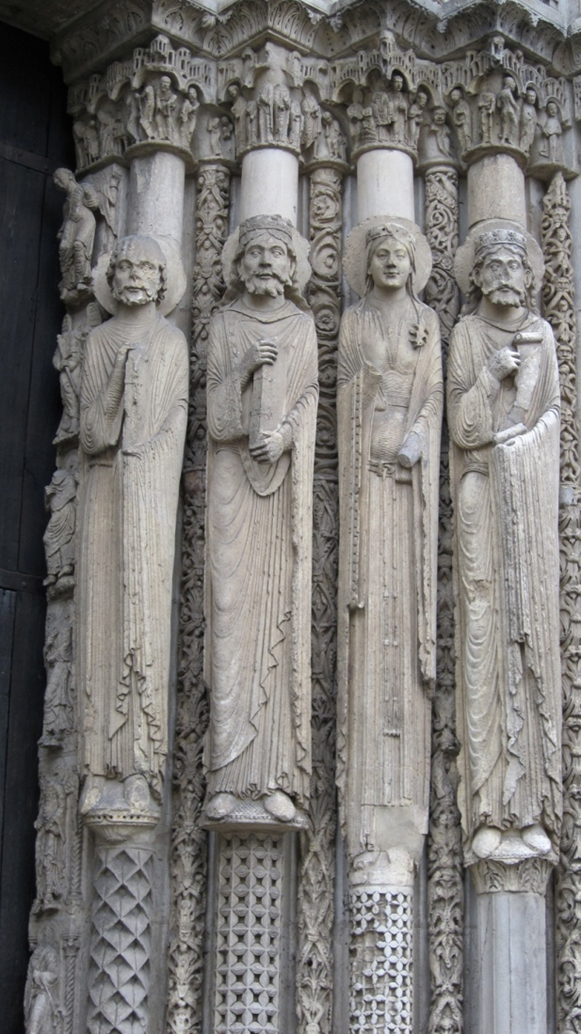
Old Testament Figures, Jambs, Royal Portal, West Facade, Chartres Cathedral, ca. 1145-1155; 13-6
-Below the earlier portal, we have a bunch of figures aligned across below each one
-These are Jam figures, they are prophets and ancestors of Christ, which Christians regard these men and women from the hebrew scriptures as foretelling their own scriptures, with the old testament below, and the new testament above

Reims Cathedral, France, ca. 1211-1286; 13-24 and 13-24a
-Almost every surface is covered with relief carvings and
-You can see through the tower because there are big openings
-Visually appears taller and is taller, reaches heavenward, going up
-Theyve put back the tympanum but its filled with stained glass, and the arches turn into cables with relief carvings

Annunciation and Visitation, Central Portal, Reims Cathedral, ca. 1230-1255; 13-25
-They are in the tympanum
-Located in the jamb
-Figures are floating starting straight ahead, depicting the figures being biblical
-Figures seem to have contrapasto
-Theres more descriptive details/features
-Theres a lot more depiction of gravity on the figures, spacial mass depiction, its just a lot more realistic compared to the other but still an attempt because its not technically realistic
-They are communicating with one another with gestures
-With the two most left figures, they represent the annunciation, and the figures on the right represent the visitation (when mary tells her cousin Elizabeth that shes going to have a miraculous birth and elizabeth has a natural one)
-The difference here with these figures compared to the royal portal ones is that these appear more 3D like and appear to have mass, they also dont just float on a pedestal, they stand, and they also just interact, not just starting straight ahead
-This shows that there is a greater interest in looking at real life, however this could be considered an attempt because their proportions are not exact
-They are moving away from the conventions and abstractions of the Middle Ages